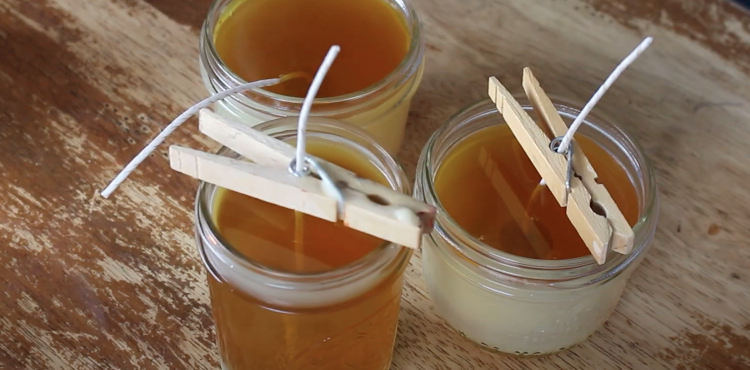I’ve experimented with virtually every natural wax available. Here’s what might surprise you – while beeswax has held its crown as the “king of waxes” for centuries, our testing revealed that certain natural alternatives outperform it in specific applications!
Whether you’re crafting candles, cosmetics, or food wraps, understanding these differences is crucial. Let’s explore the fascinating world of natural waxes and discover which one best suits your needs!
For guidance on sourcing quality beeswax, check out my list of trusted beeswax sellers for reliable suppliers.
Overview of Beeswax
Beeswax stands out among natural waxes for its unique properties:
- Melting point: 144-147°F (62-64°C)
- Natural honey scent
- Golden yellow color
- High opacity
- Long burning time
Chemical Composition:
- Esters (70-75%)
- Hydrocarbons (12-16%)
- Free fatty acids (12-14%)
- Other compounds (1-2%)
Comparison with Soy Wax
Soy wax offers distinct characteristics compared to beeswax:
Soy Wax Properties:
- Melting point: 120-180°F (49-82°C)
- White color
- Softer texture
- Good scent throw
Beeswax vs. Soy:
- Higher melting point (beeswax)
- Better structural integrity (beeswax)
- Lower cost (soy)
- Better scent throw (soy)
Performance Comparison:
- Burn time: Beeswax longer
- Scent holding: Soy better
- Hardness: Beeswax superior
- Container adhesion: Soy better
Comparison with Palm Wax
Palm wax presents unique characteristics:
Palm Wax Properties:
- Melting point: 140-180°F (60-82°C)
- Crystalline appearance
- Good hardness
- Bright white color
Beeswax vs. Palm:
- Natural fragrance (beeswax)
- Crystal patterns (palm)
- Sustainability concerns (palm)
- Cost effectiveness (palm)
Usage Considerations:
- Pillar candles: Both excellent
- Container candles: Palm better
- Natural products: Beeswax preferred
- Large-scale production: Palm more economical
Comparison with Carnauba Wax
Carnauba wax offers specific benefits:
Carnauba Properties:
- Melting point: 180-187°F (82-86°C)
- Very hard texture
- High gloss finish
- Clear appearance
Beeswax vs. Carnauba:
- Lower melting point (beeswax)
- Better flexibility (beeswax)
- Higher hardness (carnauba)
- Better shine (carnauba)
Best Applications:
- Food coating: Both suitable
- Cosmetics: Both excellent
- Polishes: Carnauba superior
- Candles: Beeswax preferred
Comparison with Candelilla Wax
Candelilla offers unique characteristics:
Candelilla Properties:
- Melting point: 155-165°F (68-74°C)
- Hard texture
- Light amber color
- Good binding properties
Beeswax vs. Candelilla:
- Natural aroma (beeswax)
- Higher shine (candelilla)
- Better plasticity (beeswax)
- Vegan option (candelilla)
Environmental Impact of Beeswax vs. Other Waxes
Sustainability Comparison:
Beeswax:
- Renewable resource
- Supports bee populations
- Low environmental impact
- Natural byproduct
Soy Wax:
- Renewable but farming-intensive
- GMO concerns
- Lower carbon footprint
- Agricultural impact
Palm Wax:
- Deforestation concerns
- Habitat destruction
- High environmental impact
- Resource-intensive
Others:
- Carnauba: Sustainable harvest
- Candelilla: Desert plant impact
- Mixed environmental effects
Uses and Applications of Beeswax
Common Applications:
Cosmetics:
- Lip balms
- Moisturizers
- Salves
- Creams
Crafts:
- Candles
- Food wraps
- Furniture polish
- Leather conditioning
Industrial:
- Waterproofing
- Coatings
- Adhesives
- Polishes
Pros and Cons of Beeswax
Advantages:
- Natural antiseptic properties
- Long burning time
- Pleasant natural scent
- Good stability
- Versatile applications
Disadvantages:
- Higher cost
- Temperature sensitivity
- Color variations
- Limited availability
- Harder to work with
Aromatherapy and Scent Throw Capabilities
Scent Performance:
Beeswax:
- Natural honey scent
- Moderate scent throw
- Good for essential oils
- Subtle fragrance
Other Waxes:
- Soy: Excellent throw
- Palm: Good throw
- Carnauba: Poor throw
- Candelilla: Moderate throw
Best Practices:
- Temperature control
- Proper oil percentages
- Curing time
- Blend considerations
Cost Analysis of Beeswax Versus Other Natural Waxes
Price Comparison (Per Pound):
- Beeswax: $15-25
- Soy Wax: $4-8
- Palm Wax: $5-10
- Carnauba: $12-20
- Candelilla: $10-15
Value Considerations:
Performance factors:
- Burn time
- Scent throw
- Ease of use
- Final product quality
Economic factors:
- Yield
- Processing requirements
- Storage needs
- Market value
Long-term Cost Analysis:
- Initial investment
- Processing costs
- Equipment needs
- Labor requirements
- Market pricing
Making Your Selection
Consider these factors:
- Intended use
- Budget constraints
- Environmental impact
- Required properties
- Available resources
For best results:
- Test multiple options
- Start with small batches
- Document results
- Consider blending waxes
- Monitor performance
While each natural wax brings unique qualities to the table, your choice ultimately depends on your specific needs and values. Consider factors like sustainability, cost, performance, and ethical sourcing when making your selection.
Whether you choose traditional beeswax or explore alternatives, nature provides an incredible palette of options for your creative projects. Happy crafting with whichever wax aligns best with your goals!







